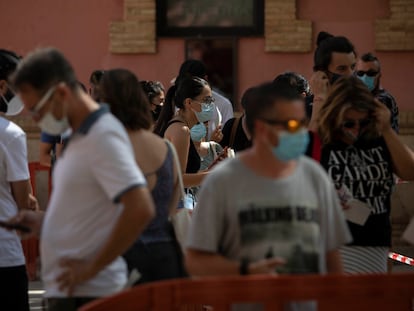Spain reports 37,000 new coronavirus infections in the last week
Madrid, Aragón and the Basque Country are at the top of the list for newly reported cases, with an 11% rise in total confirmed infections since the epidemic began
The diagnosis of new coronavirus cases in Spain continues to accelerate. While the number of cases detected in the last 24 hours reported on Monday evening by the Health Ministry is lower than that cited on Friday — nearly 3,000 then compared to 1,838 on Monday, presumably lower than the real figure given that Saturday was a national holiday — all the other indicators continue to rise compared to previous weeks.
Spain has confirmed a total of 359,082 cases since the crisis began, according to the data presented on Monday by Fernando Simón, the director of the Health Ministry’s Coordination Center for Health Alerts. This is nearly 37,000 more than just a week ago, which represents an increase of 11% in just seven days.
The accumulated incidence of coronavirus cases, which last week exceeded 100 cases per 100,000 inhabitants in the previous 14 days for the first time since the deescalation of confinement measures, has also increased since Friday, going from 109 to 125 cases per 100,000 inhabitants.
I’m prudent and I’ll go as far as to say that we are detecting between 60% and 70%, but it is possible that we are detecting even moreFernando Simón
Madrid, with 10,000 confirmed infections in the last seven days, is the region that has contributed most to this weekly rise, although when viewed in relation to population Aragón and the Basque Country are the regions that have most contributed to the general total, with 3,400 and 3,200 new cases, respectively.
Without seeking to minimize the importance of these rises, Simón explained that he was not particularly concerned by the latest numbers. “We can have a certain confidence that we are detecting a lot, a lot of what there is,” he said, in reference to the number of total infections. “I’m prudent and I’ll go as far as to say that [we are detecting] between 60% and 70%, but it is possible that we are detecting even more,” he continued.
The Health Ministry has been pointing to the efforts being made by the regions to carry out more tests and to focus on particular collectives or areas, such as the random testing that has been started in regions such as Catalonia and Madrid in neighborhoods with high infection rates, and the work to track and trace contacts in areas such as Aragón.
We need to arrive at the start of work and education activity in September with the lowest level of transmission that we can manage, that is the fundamental targetFernando Simón
“We are seeing a significant detection capacity in particular because we are carrying out a lot of diagnostic tests, but also because we are doing so in a sufficiently focused way,” Simón added. The objective is the start of the school year, he explained. “We need to arrive at the start of work and education activity in September with the lowest level of transmission that we can manage, that is the fundamental target,” he said.
As for the hardest-hit regions, the ministry official said that “the situation in Madrid is worrying,” but he went on to point out that the region is “in the situation in which Catalonia found itself a few weeks ago.” The northeastern region has since managed to improve its coronavirus data. As for Aragón, Simón said that the region was showing “an adequate trend” having stabilized its numbers after “going through a very delicate situation.”
Simón divided the regions into three groups: the first made up of those “who have gone through a bad situation” in recent weeks, forcing them to implement control measures, albeit lifting them once the data improved. The second group is made up of regions such as Madrid, which had a favorable epidemiological situation previously but has seen it worsen in recent days. The third is the areas that “haven’t seen, nor are they currently seeing” a problematic situation.
The data released on Monday by the ministry shows growth of nearly 50% in the number of new cases diagnosed where symptoms began in the last 14 days, one of the indicators to which the experts pay more attention in order to calibrate the progress of the epidemic. This figure went from 12,300 positives last Monday to 18,000 yesterday.
The increase is even greater, around 60%, in terms of the number of patients with symptoms detected in the last week, which has risen from 3,300 to 5,300 over the last seven days.
Also of note are the rises in hospitalizations. The ministry reported on Monday that 4,124 people are currently in Spanish hospitals with Covid-19, 474 of them in intensive care. This is a rise of 529 patients compared to last Thursday. But, Simón said, the pressure on Spain’s healthcare system is “in principle acceptable. The pressure is not currently excessive, but in some hospitals we are starting to observe situations that are not putting staff at risk but that are putting them under stress. We are not doing badly but things are not going as we would like,” he concluded.
The data reported by the ministry on a daily basis show lower numbers than the totals provided by the regions on the same day, given the accounting system used by the ministry, which only includes on its daily tables cases that have been revised and confirmed.
Simón also had a warning ahead of the start of the school year, which is just weeks away. “Investment is needed,” he said. “If we want to keep the children at a distance from one another, that requires space and staggering the classes over more hours during the day. If we want stable groups, which will not mean a major problem for public health, they need to be relatively small,” he said.
The official said that children “cannot be” in groups of 50 students, but rather 15 to 20, “or the number that is eventually decided on within each region.” Canteens, school yards and non-academic activities “will have to have rules that will have to be observed,” he continued. “If they aren’t, the risks of infection will be the same as we had in March.”
English version by Simon Hunter.
Tu suscripción se está usando en otro dispositivo
¿Quieres añadir otro usuario a tu suscripción?
Si continúas leyendo en este dispositivo, no se podrá leer en el otro.
FlechaTu suscripción se está usando en otro dispositivo y solo puedes acceder a EL PAÍS desde un dispositivo a la vez.
Si quieres compartir tu cuenta, cambia tu suscripción a la modalidad Premium, así podrás añadir otro usuario. Cada uno accederá con su propia cuenta de email, lo que os permitirá personalizar vuestra experiencia en EL PAÍS.
¿Tienes una suscripción de empresa? Accede aquí para contratar más cuentas.
En el caso de no saber quién está usando tu cuenta, te recomendamos cambiar tu contraseña aquí.
Si decides continuar compartiendo tu cuenta, este mensaje se mostrará en tu dispositivo y en el de la otra persona que está usando tu cuenta de forma indefinida, afectando a tu experiencia de lectura. Puedes consultar aquí los términos y condiciones de la suscripción digital.
More information
Últimas noticias
New York enters the era of Zohran Mamdani
Welcome to the post-religion era: The idea of Christianity as the absolute truth has become obsolete
‘I thought you would like it’: The risky sexual practice popularized by TV shows and TikTok
The digitalization of tourism: ‘They promise experiences and gave us the worst possible one’
Most viewed
- Sinaloa Cartel war is taking its toll on Los Chapitos
- Reinhard Genzel, Nobel laureate in physics: ‘One-minute videos will never give you the truth’
- Oona Chaplin: ‘I told James Cameron that I was living in a treehouse and starting a permaculture project with a friend’
- Why the price of coffee has skyrocketed: from Brazilian plantations to specialty coffee houses
- Silver prices are going crazy: This is what’s fueling the rally










































